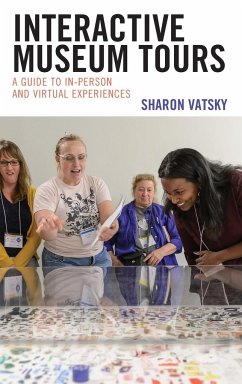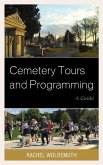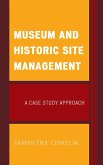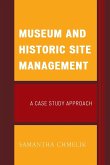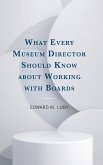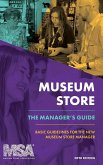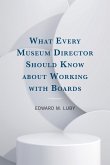- Gebundenes Buch
- Merkliste
- Auf die Merkliste
- Bewerten Bewerten
- Teilen
- Produkt teilen
- Produkterinnerung
- Produkterinnerung
This easy-to-follow yet comprehensive book provides everything an educator working in a museum or school, in person or online, needs to develop experiences that encourage close looking, spark the imagination, and support the development of critical thinking skills.
Andere Kunden interessierten sich auch für
![Cemetery Tours and Programming Cemetery Tours and Programming]() Rachel WolgemuthCemetery Tours and Programming101,99 €
Rachel WolgemuthCemetery Tours and Programming101,99 €![Cemetery Tours and Programming Cemetery Tours and Programming]() Rachel WolgemuthCemetery Tours and Programming52,99 €
Rachel WolgemuthCemetery Tours and Programming52,99 €![Museum and Historic Site Management Museum and Historic Site Management]() Samantha ChmelikMuseum and Historic Site Management90,99 €
Samantha ChmelikMuseum and Historic Site Management90,99 €![Museum and Historic Site Management Museum and Historic Site Management]() Samantha ChmelikMuseum and Historic Site Management45,99 €
Samantha ChmelikMuseum and Historic Site Management45,99 €![What Every Museum Director Should Know about Working with Boards What Every Museum Director Should Know about Working with Boards]() Edward M. LubyWhat Every Museum Director Should Know about Working with Boards108,99 €
Edward M. LubyWhat Every Museum Director Should Know about Working with Boards108,99 €![Museum Store Museum Store]() Museum Store AssociationMuseum Store112,99 €
Museum Store AssociationMuseum Store112,99 €![What Every Museum Director Should Know about Working with Boards What Every Museum Director Should Know about Working with Boards]() Edward M. LubyWhat Every Museum Director Should Know about Working with Boards45,99 €
Edward M. LubyWhat Every Museum Director Should Know about Working with Boards45,99 €-
-
-
This easy-to-follow yet comprehensive book provides everything an educator working in a museum or school, in person or online, needs to develop experiences that encourage close looking, spark the imagination, and support the development of critical thinking skills.
Produktdetails
- Produktdetails
- Verlag: Rowman & Littlefield Publishers
- Seitenzahl: 244
- Erscheinungstermin: 21. April 2023
- Englisch
- Abmessung: 235mm x 157mm x 19mm
- Gewicht: 552g
- ISBN-13: 9781538167403
- ISBN-10: 1538167409
- Artikelnr.: 66276594
- Herstellerkennzeichnung
- Libri GmbH
- Europaallee 1
- 36244 Bad Hersfeld
- gpsr@libri.de
- Verlag: Rowman & Littlefield Publishers
- Seitenzahl: 244
- Erscheinungstermin: 21. April 2023
- Englisch
- Abmessung: 235mm x 157mm x 19mm
- Gewicht: 552g
- ISBN-13: 9781538167403
- ISBN-10: 1538167409
- Artikelnr.: 66276594
- Herstellerkennzeichnung
- Libri GmbH
- Europaallee 1
- 36244 Bad Hersfeld
- gpsr@libri.de
Sharon Vatsky is a lifelong educator. Her career in museum education includes a decade as Curator of Education at the Queens Museum and more than twenty years at the Solomon R. Guggenheim Museum, most recently as Director of Visitor Engagement. Sharon brings her experience as a lifelong art educator and museum educator to facilitating gallery and virtual experiences for varied audiences. She has conducted workshops for teachers and museum educators at universities and art museums in the U.S. and internationally and taught graduate level courses in Museum Education at the City University of New York, Teachers College, Columbia University and New York University's Graduate Program in Museum Studies as well as undergraduate courses in drawing, painting, design and art history and arts education. Her first book, Museum Gallery Activities: A Handbook was published in 2018 by Roman and Littlefield.
List of Illustrations
Preface
Acknowledgements
Part I: The Big Picture
Chapter 1: Why Museum Tours Still Matter
Chapter 2: An Introduction to Thematic Tours
Part II: Planning
Chapter 3: The Tour Planning Template
Chapter 4: Choosing a Theme
Chapter 5: Object Selection and Sequencing
Chapter 6: Writing and Sequencing Open-Ended Questions
Chapter 7: The Role of Information
Chapter 8: Multi-Modal Activities
Chapter 9: Advance Organizers, Transitions, Reflections
Chapter 10: Getting Ready
Part III: Facilitation
Chapter 11: Greeting and Orientation
Chapter 12: Supporting Participation
Chapter 13: Reflection and Evaluation
Part IV: Adapting the Tour Planning Template for Diverse Audiences
Chapter 14: Audience at the Center
Chapter 15: Adapting the Tour Planning Template for Youth Queena Ko
Chapter 16: Adapting the Tour Planning Template for Students on the Autism
Spectrum Melanie Adsit and Jackie Delamatre
Chapter 17: Adapting the Tour Planning Template for Social and Emotional
Learning Lisa Mazzola
Chapter 18: Adapting the Tour Planning Template for Family Tours Emily
Rivlin-Nadler
Chapter 19: Adapting the Tour Planning Template for Virtual Tours for
Adults
Chapter 20: Adapting the Tour Planning Template for Adults with Visual
Impairments and Blindness Karen Bergman
Chapter 21: Adapting the Tour Planning Template for Adults with Alzheimer's
Disease and other Dementias Francesca Rosenberg
Appendix 1: Questionnaire on Gallery and Virtual Museum Teaching
Appendix 2: Tour Planning Checklist
Appendix 3: Tour Planning Template
Bibliography
About the Contributors
About the Author
Index
Preface
Acknowledgements
Part I: The Big Picture
Chapter 1: Why Museum Tours Still Matter
Chapter 2: An Introduction to Thematic Tours
Part II: Planning
Chapter 3: The Tour Planning Template
Chapter 4: Choosing a Theme
Chapter 5: Object Selection and Sequencing
Chapter 6: Writing and Sequencing Open-Ended Questions
Chapter 7: The Role of Information
Chapter 8: Multi-Modal Activities
Chapter 9: Advance Organizers, Transitions, Reflections
Chapter 10: Getting Ready
Part III: Facilitation
Chapter 11: Greeting and Orientation
Chapter 12: Supporting Participation
Chapter 13: Reflection and Evaluation
Part IV: Adapting the Tour Planning Template for Diverse Audiences
Chapter 14: Audience at the Center
Chapter 15: Adapting the Tour Planning Template for Youth Queena Ko
Chapter 16: Adapting the Tour Planning Template for Students on the Autism
Spectrum Melanie Adsit and Jackie Delamatre
Chapter 17: Adapting the Tour Planning Template for Social and Emotional
Learning Lisa Mazzola
Chapter 18: Adapting the Tour Planning Template for Family Tours Emily
Rivlin-Nadler
Chapter 19: Adapting the Tour Planning Template for Virtual Tours for
Adults
Chapter 20: Adapting the Tour Planning Template for Adults with Visual
Impairments and Blindness Karen Bergman
Chapter 21: Adapting the Tour Planning Template for Adults with Alzheimer's
Disease and other Dementias Francesca Rosenberg
Appendix 1: Questionnaire on Gallery and Virtual Museum Teaching
Appendix 2: Tour Planning Checklist
Appendix 3: Tour Planning Template
Bibliography
About the Contributors
About the Author
Index
List of Illustrations
Preface
Acknowledgements
Part I: The Big Picture
Chapter 1: Why Museum Tours Still Matter
Chapter 2: An Introduction to Thematic Tours
Part II: Planning
Chapter 3: The Tour Planning Template
Chapter 4: Choosing a Theme
Chapter 5: Object Selection and Sequencing
Chapter 6: Writing and Sequencing Open-Ended Questions
Chapter 7: The Role of Information
Chapter 8: Multi-Modal Activities
Chapter 9: Advance Organizers, Transitions, Reflections
Chapter 10: Getting Ready
Part III: Facilitation
Chapter 11: Greeting and Orientation
Chapter 12: Supporting Participation
Chapter 13: Reflection and Evaluation
Part IV: Adapting the Tour Planning Template for Diverse Audiences
Chapter 14: Audience at the Center
Chapter 15: Adapting the Tour Planning Template for Youth Queena Ko
Chapter 16: Adapting the Tour Planning Template for Students on the Autism
Spectrum Melanie Adsit and Jackie Delamatre
Chapter 17: Adapting the Tour Planning Template for Social and Emotional
Learning Lisa Mazzola
Chapter 18: Adapting the Tour Planning Template for Family Tours Emily
Rivlin-Nadler
Chapter 19: Adapting the Tour Planning Template for Virtual Tours for
Adults
Chapter 20: Adapting the Tour Planning Template for Adults with Visual
Impairments and Blindness Karen Bergman
Chapter 21: Adapting the Tour Planning Template for Adults with Alzheimer's
Disease and other Dementias Francesca Rosenberg
Appendix 1: Questionnaire on Gallery and Virtual Museum Teaching
Appendix 2: Tour Planning Checklist
Appendix 3: Tour Planning Template
Bibliography
About the Contributors
About the Author
Index
Preface
Acknowledgements
Part I: The Big Picture
Chapter 1: Why Museum Tours Still Matter
Chapter 2: An Introduction to Thematic Tours
Part II: Planning
Chapter 3: The Tour Planning Template
Chapter 4: Choosing a Theme
Chapter 5: Object Selection and Sequencing
Chapter 6: Writing and Sequencing Open-Ended Questions
Chapter 7: The Role of Information
Chapter 8: Multi-Modal Activities
Chapter 9: Advance Organizers, Transitions, Reflections
Chapter 10: Getting Ready
Part III: Facilitation
Chapter 11: Greeting and Orientation
Chapter 12: Supporting Participation
Chapter 13: Reflection and Evaluation
Part IV: Adapting the Tour Planning Template for Diverse Audiences
Chapter 14: Audience at the Center
Chapter 15: Adapting the Tour Planning Template for Youth Queena Ko
Chapter 16: Adapting the Tour Planning Template for Students on the Autism
Spectrum Melanie Adsit and Jackie Delamatre
Chapter 17: Adapting the Tour Planning Template for Social and Emotional
Learning Lisa Mazzola
Chapter 18: Adapting the Tour Planning Template for Family Tours Emily
Rivlin-Nadler
Chapter 19: Adapting the Tour Planning Template for Virtual Tours for
Adults
Chapter 20: Adapting the Tour Planning Template for Adults with Visual
Impairments and Blindness Karen Bergman
Chapter 21: Adapting the Tour Planning Template for Adults with Alzheimer's
Disease and other Dementias Francesca Rosenberg
Appendix 1: Questionnaire on Gallery and Virtual Museum Teaching
Appendix 2: Tour Planning Checklist
Appendix 3: Tour Planning Template
Bibliography
About the Contributors
About the Author
Index

